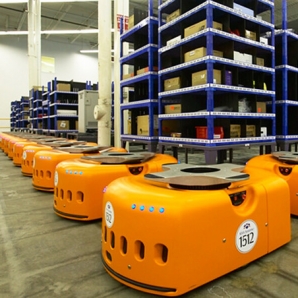Kiva Robots for an Automated Warehouse
With the revolution in ecommerce, vouchers sites are a hot topic. Many people use sites like voucherbin.co.uk to get discount codes and offers to save money but most consumers aren't aware of the amazing technology that goes on behind the ecommerce websites that they use. This article will take a look at the process of packaging, delivery and shipping.
With an ever increasing number of online orders placed globally each day and an equally demanding customer expectation for accurate orders and speedy delivery times, distributors are having to stay on their toes in order to fulfill the demand in this fast paced and competitive industry. With mobile ecommerce propelling online shopping by around 18% annual growth, a new, quicker but inexpensive solution to distribution has proved essential for companies to stay competitive with their ecommerce rivals, since any delay or lack of accuracy on orders means not only a lost order, but also a lost customer. Cue the the Kiva Robot.
So, why is Kiva today recognized as the best solution for ecommerce fulfillment? Well, after dishing out $775 million in 2012 for Kiva Systems, Amazon has managed to up their inventory capabilities by 50%, and in the lead up to Christmas, cut its operating costs by 20% whilst delivering more quickly and more efficiently. In the Quiet Logistics fulfillment center where over 1.5 million items are stored, a Kiva robot fetches 30,000 orders per day (4 times the amount a human could do) with a 99.9% accuracy score, making Kiva the best solution for ecommerce fulfillment today.
So how exactly does it do it? Well, as soon as you click ‘buy’ and confirm an order online, a Kiva robot’s work begins. First the software checks the Kiva database, then the robot closest to your item in the warehouse is located and directed to collect your item. Next, using a network of barcodes on the floor of the warehouse, the robot directs itself around the 300,000 square foot warehouse until it finds its target where it then slides underneath and lifts the pod off the floor and onto its back. Using sensors to ensure non-collision, it carries the pod to the shipping area where human workers then retrieve the purchase for shipment, taking only 15 minutes to complete the entire process from when you click to order your item, to shipping. The Kiva robots move at around 5mph, can carry up to 720 pounds and cover 12 miles of ground per day, 24 hours a day, 365 days a year. Not only do they work quicker, more accurately and for longer periods than any human could manage, they are also extremely energy efficient, requiring only 5 minutes per hour to re-charge, making them currently the most effective solution to fulfil our rapidly increasing ecommerce demands.
This of course begs the question; with a robot designed to complete tasks with a speed and efficiency with which no human can compete, at a lower cost, with over 15,000 already in use across the US, what does this mean for the future job market? Opinion is split ... Quiet Logistics claims that the 100 robots present in their warehouse work in harmony with their 300 human warehouse associates, decreasing worker stress and over-activity, allowing them to walk less and complete tasks in a more organized manner with a lesser chance of mistakes occurring. They also suggest that the robots have actually created jobs since without them the company wouldn’t have grown at such a rate, thus requiring more human workers than previously. In support of this claim, Amazon announced that they will be hiring 80,000 seasonal employees this Christmas in order to fulfill customer orders, a 14% increase on the previous year and expects thousands of those workers to be kept on as permanent full-time employees.
So, it could be argued that with the increase of delivery capabilities, and therefore order quantities, by allowing the companies to be highly efficient thus giving them the ability to compete globally, the Kiva robot may actually increase the number of employee positions. However, according to Pew Report, robots will eventually take over half of all human jobs within a decade or two. So, the verdict is out on that one, but what we do know is that with increased cycle time, scalability, accuracy, seasonality and log-tail inventory, all in keeping with a sustained or lowered operating expense, the Kiva robot for Inventory Management is here to stay.



















